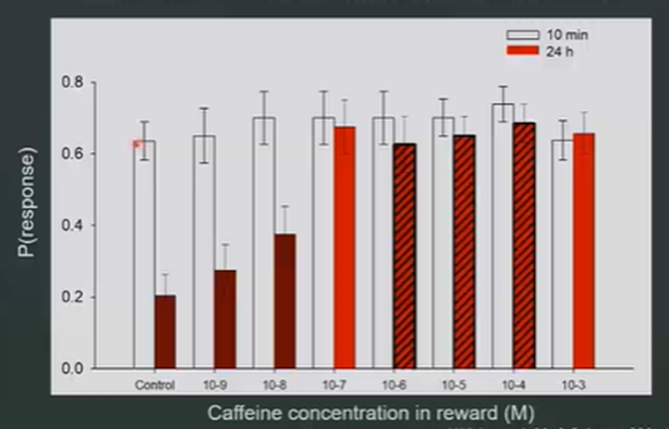Insecticides
1/32
There's no tags or description
Looks like no tags are added yet.
Name | Mastery | Learn | Test | Matching | Spaced |
|---|
No study sessions yet.
33 Terms
definitions of pest and pesticide
What is a pesticide?
Any drug or mixture of substance which is intended for preventing, destroying, repelling or mitigating any pest
Pesticides include nematicides, rodenticides, insecticides, herbicides and fungicides
Not always very selective
What is a pest?
Any species which has a harmful effect to humans: food, living conditions etc
Destructive effects on food, crops, livestock
Often species which evade natural enemies
Often worse when non endemic
why do we need insecticides
Population growth – more people to feed, clothe and house when we lose 1/5 of the worlds crops to pests
Crop yield needs to increase, more natural fibres needed to be produced
Most pesticides are not selectively toxic to invertebrates
Why do we need to understand the mode of action of these drugs?
Protecting pollinators
Use them safely
Insects have good resistant mechanisms – genetics and fast reproduction time allow them to adapt many niches
Pest management needs to be specific – applied at a specific time, specific compounds
characteristics of pests
Characteristsic of pest species
R selecting species
High growth rate
Parents can produce many offspring
Usually pests
K selecting species
Low growth rate
Few offspring
Usually not pests
what is an outbreak
large sporadic populations of insect pests usually cause outbreaks
an outbreak is when population level rises above equilibrium level
E.g: armyworm on maize
causes of pest outbreaks
monocultures – when one crop is grown over a large area of land which attracts pests
highly nutritious crops
also removes natural enemies when growing crops
food is grown all year round
were now reliant on these chemicals which leads to resistance
5 common scenarios which lead to these outbreaks
moved into a new environment —> for example due to climate change animals migrate to different environments
introduction from abroad
destruction of natural enemies —> insecticides take out their predators
development of resistance
higher quality standards —> we demand perfect fruits and vegetables which puts pressures on farmers
economic consequence of pests: injury vs damage
Injury vs Damage
injury is defined as the physical harm caused to a plant or destruction of a valued commodity caused by the presence or activity of a pest (E.g: feeding on leaves, feeding on blood etc)
damage is the monetary value lost to the commodity as a result of injury by the pest (E.g: spoilage, reduction in yield, loss of quality etc)
any level of pest infestation causes injury, but not all levels of injury cause damage à important to know when to intervene
economic injury
Economic injury level
trying to control a population not eradicate it
economic injury level is the pest density at which there is a greatest difference between the cost and the benefit of pest control
ideally you want a large distance between these two curves
EIL is the economic injury level
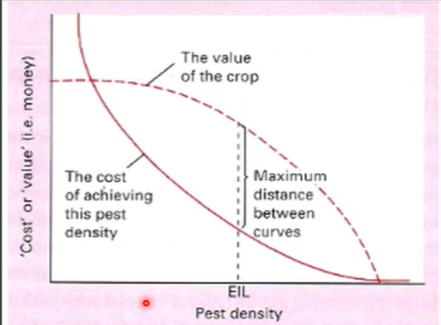
Something becomes a pest when the equilibrium abundance is above the economic injury
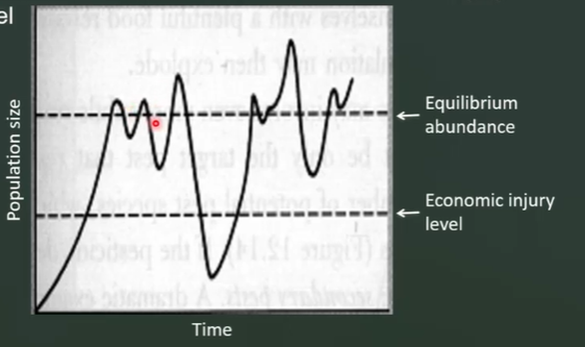
Something is not a pest is the equilibrium abundance is below the economic injury
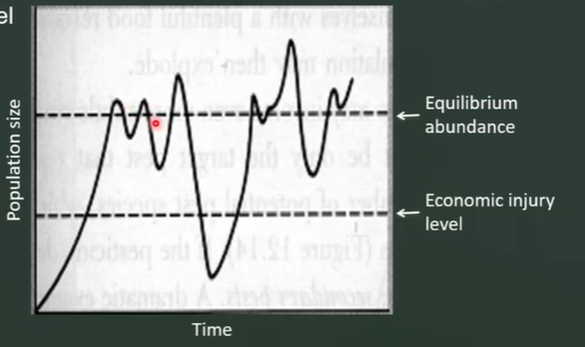
why do we still use pesticides
Stakeholders in pest management
Governments and funding agencies
Research scientists
Farmers and growers
Commercial companies
Dependence on pesticides varies by crop and pest
Some crops are entirely reliat on insecticide use
Some crops produce similar yield but the quality fs lower
Some have very marginal benefits
types of insecticides
Varies between dusts, aerosols, bait, granules etc
We can be more selective through the way that we apply these —> method of application can aid selective toxicity
Often not pure, mixed with inert materials which change the physical and chemical properties of the compounds
Need to protect the crop at all different levels, when its harvested, when its packaged etc
Insecticide uptake
3 main routes of entering the organism:
Permeating though the cuticle
Gas exchange
Direct ingestion of insecticides
Permeating the cuticle
Insects have cuticle to waterproof —> keeps moisture in the body
Epicuticle, exocuticle, endocuticle then epidermis
Epicuticle is external membrane
Exocuticle is lipophilic
Endocuticle is hydrophilic
Carbaryl (topical insecticide) penetrates through insect cuticle of insect species at dif rates
Some insects such as boll weevil and rice weevil have thick exocuticles
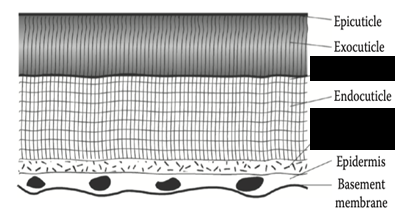
times to target the insect cuticle
Hemimetabolous insects – likely that any drug will have the same level of permeability at all stages of its life cycle
Holometabolous insects have different life stages where the degree of cuticle permeability varies
Hemimetabolous insects go through nymphal stages where they grow and then form etc, but from hatching the cuticle is fully formed —> unlikely we can be time specific in developmental stages
From an egg they go through larval stage, prepupateon stage and then pupateon stage, adulthood
Insects have different structures, in larval stages have very thick endocuticle (water soluble) and thin exocuticle, in adulthood this switches —> can target different life stages.
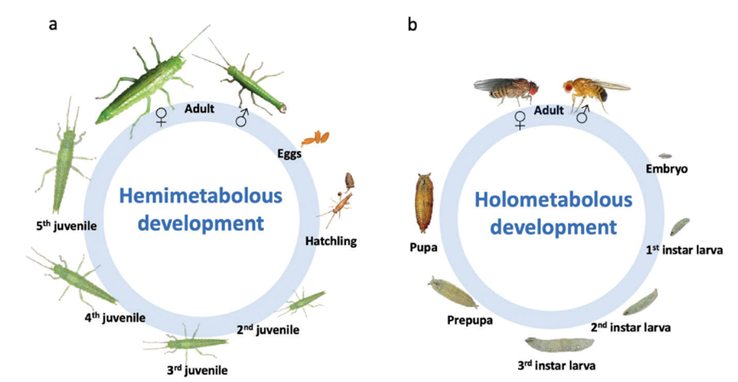
Insecticide uptake
3 main routes of entering the organism:
Permeating though the cuticle
Gas exchange
Direct ingestion of insecticides
Gas exchange
Trachea through abdomen and thorax which undergoes gas exchange
Direct ingestion
Systemic ingestion
Usually applied to the seeds and dispersed through the plant
Can also be applied to the surface of the plant – sometimes can be washed off though
Insects then consume the plant
insect diversity
29 insect orders
Coleoptera (beetles), diptera (flies), Hymenoptera (bees and wasps) and lepidoptera (moths)
grouping insecticides
Grouping insecticides
Often grouped by chemical class, target site or mode of action
Generally 4 ways in which insecticides act
Modulate target site
Cause excitation
Blockage of membrane proteins
Inhibition
target the nervous system
Toxicity is measured using LD50 à low LD50 is a very toxic drug
Not all insect nervous systems are the same, both fly and cockroach have a brain structure, suboesophageal ganglion, The main difference is whether they have compound ganglion or thoracic ganglia and abdominal ganglia
Insects with ganglia throughout have a greater surface area of nervous tissue to attack
Mainly works by interrupting the electrical or chemical communication
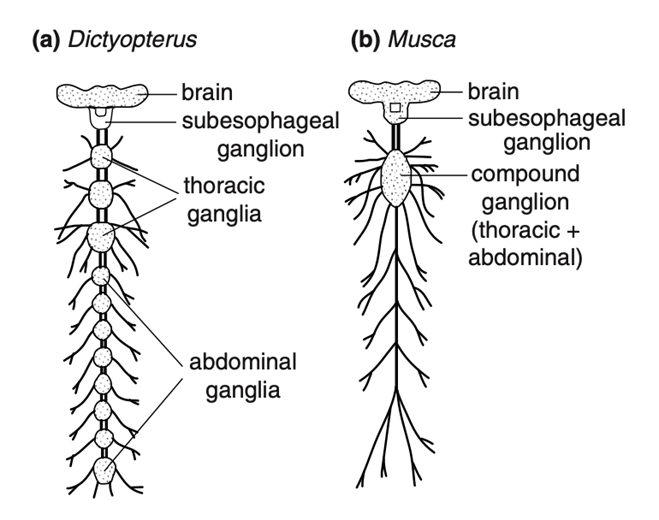
Organochlorines - DDT
DDT one of the first insecticides, now banned
Targets voltage gated sodium channels in axons of neurons
Modulates the sodium channels —> keeps the channel open so sodium fluxes in
Highly hydrophobic —> penetrates through waxy cuticle as contact poison
Little interaction with water, not hydrolysed, bioaccumulates in lipid tissues of high order animals
Very stable
LD50 is 250mg/kg for a rat
Binds within the lipid membrane
By sodium fluxing into the cell results in a slow long after potential, causes repeated action potentials —> leads to cell exhaustion
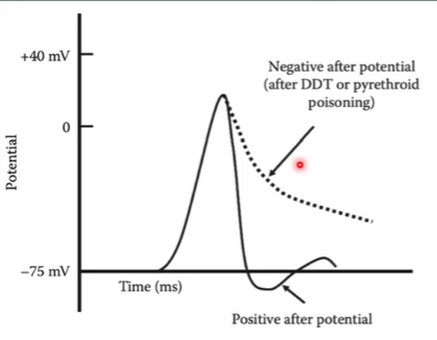
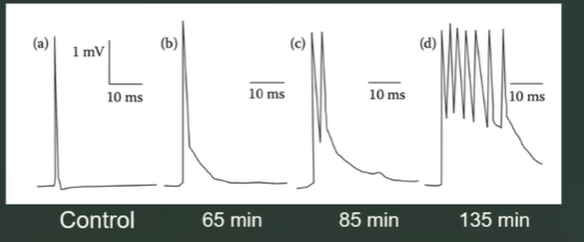
We dot have a lipophilic membrane, so was deemed safe for humans, does cause issues when penetrated into the lipid membranes of tissues
Mosquitos developed resistance
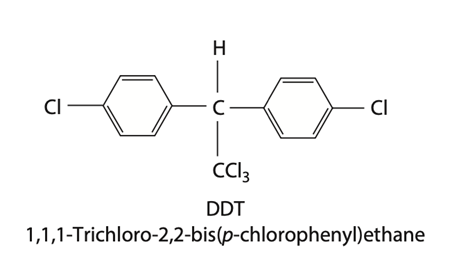
pyrethroids
Similar in target site and mode of action, also keep sodium pores open
LD50 is 1500mg/kg in rats, much less toxic drug for mammals
2 types of pyrethroids
Type 1: repetitive discharge (multiple spikes), slow after potentials (also found with DDT)
Type 2: no repetitive discharge, very slow after potential
Pyrethroids have ester bonds which can be cleaved by hydrolysis, microorganisms can metabolise the products
Main drugs used today
Synthetic but based off pyrethrum produced by chrysanthemum flowers
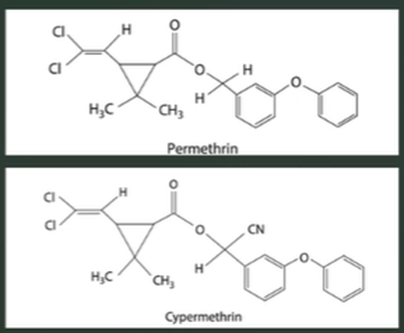
phenylpyrazoles
Small group of insecticides
Target is GABA and glutamate-gated chloride channels, block GABA and glutamate binding
Usually chloride influxes as negative ion, important for post-synaptic control, bringing cells back to resting potential
When chloride can't move into the cell, sustained potential
Selectively toxic as we only find glutamate gated chloride channels in invertebrates
Figure shows the difference between a normal situation on the left with GABA returning to memb potentials, and then on the right when fipronil (phenylpyrazole) is added
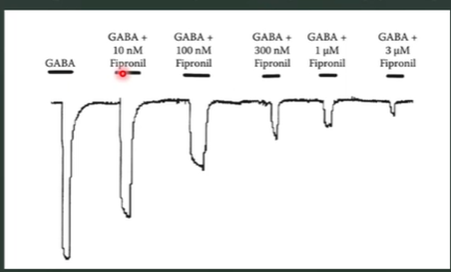
neonicatnoids
Nicotine is an alkaloid produced naturally by plants to deter herbivory
Agonists of ach, bind to ach receptors
More chemical than electrical intervention
Causes sustained excitation of neurons and is not hydrolysed by acetylcholinesterase
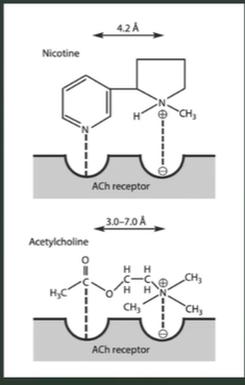
organophosphates
Dominant group in terms of number of compounds
Derivatives of phosphoric acid, oxygen can be replaced by S, C and N to yield different derivatives
Extremely toxic
Targets acetylcholinesterase, inhibits action by phosphorylation
Can be dephosphorylated by hydrolysis but can take days and weeks, so is classed as irreversible
non neurotoxic insecticides
insect growth regulators
cuticle dehydrators
Insect growth regulators
Juvenoids are one type which mimic juvenile hormones
Methoprene a type of juvenoid and is a mimic of juvenile hormone
Can pause malting, cause early or late malting (E represents a malting stage on the figure)
If timed properly, the insect will develop into an adult but will not be able to reproduce
If we intervene with these malting stages the insect doesn’t develop properly __. Fly reproduce etc
Slower approach than neurotoxins
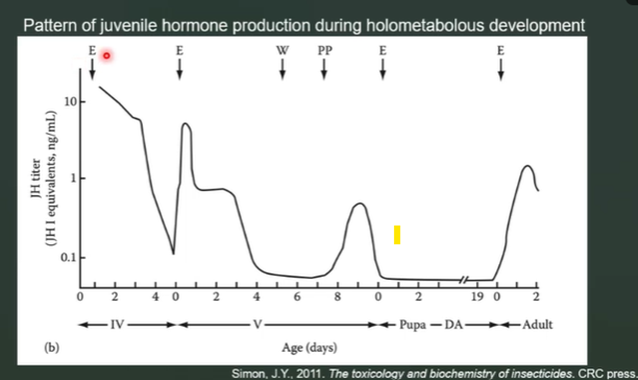
non neurotoxic insecticides
insect growth regulators
cuticle dehydrators
Cuticle dehydrators
Disrupts the lipid membrane of the insect, water passively leaves the body, insect dehydrates and dies
E.g: diatomaceous earth, fossilised diatoms
Safest for humans
combinations
Combinations
When applying insecticides we aim to only expose insects to one at a time but in reality insects in their natural environments are exposed to a whole cocktail of naturally produced insecticides
insecticides in food chains
Assumed safe for mammals as we don’t have a waxy cuticle
Actually enters food chains – first noticed when there was a decrease in bird population
Highly lipophilic, doesn’t biodegrade – half-life in soil between 3 and 10 years
DDT applied to treat the insects which cause Dutch Elms disease
Worms in soil passively accumulating in worms and in robins brain —> the concentration of DDT in the tissues of birds was higher than the concentration used to treat the insects
7000 fold increase in the bioaccumulation between mud sample (bottom of the food chain) and herring guls (top of the food chain)
Even found in breast milk
Modern drugs much more likely to be biodegraded by UV light
impact on birds
However bird population is still declining
Even though a low concentration, these birds still exposed to modern drugs
The insects which the birds feed on are being killed —> no food source
Turns out that egg shells were thinning – just a mother sitting on the egg could break the egg
Turns out that DDT was causing egg shell thinning as it interfered with calcium transport in shell gland
The amount of pigmentation in sparrowhawk eggs is also an indicator if insecticide contamination
When concentrations of imidacloprid is high, we lose biodeiversity
modern insecticides
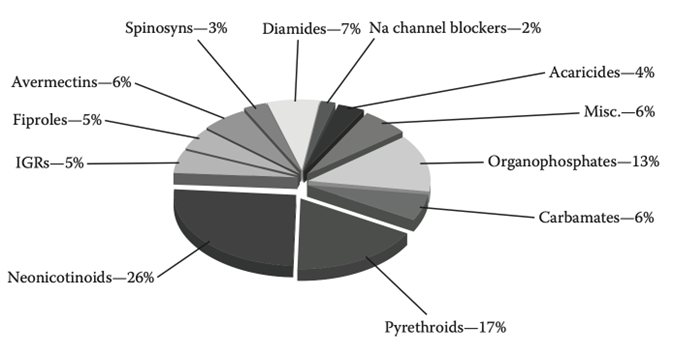
affect on bees
70% of crops depend on pollination
Very reliant on crops to feed the increasing population
Bees are very dependent on a range of plants to thrive
Often bees are transported to monoculture fields to pollinate them but this places them under a lot of environmental stress (not diverse food source, placed in trucks and carted to different area, exposed to insecticides etc)
Leads to a 30% decline in bee colonies
Other effects of neonictanoids on bees:
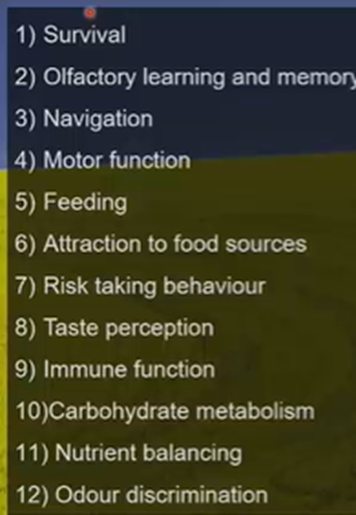
neonictanoids
Systemic drug – applied to the seeds but as the plant develiops is transported to al the tissues via the xyxlem
End up in nectar and pollen
Exposure level very low (1-5ppb)
Is water soluble
As its present in root tissue makes its way into the environment
classical conditioning of bees
Complex set of visual and olfactory cues produced by flowers that pollinators use to identify and discriminate flowers
Can classically condition bees to remember certain odours and incentivise them to seek out these odours
Conditioned stimulus: odour (what we want the bee to remember)
Unconditioned stimulus: reward
Bees taste with their antenna and mouth parts which projects to the suboesophageal ganglion
If the stimulus is sufficient it triggers a reflex called the proboscis extension reflex causing the bee to seek out this odour
In the lab we touch the antenna with a sucrose solution whilst blowing the odour over the bee we can incentivise it to seek out this odour
We can follow this up to a reward (sucrose) to classically condition the bee so that if they smell the odour they will taste the compound without the stimulus touch of the sucrose on the antenna
However, neonicotinoids inhibit honeybees' ability to recall a learned association between nectar reward and floral scent.
where do neonictanoids target the bee brain
Mushroom bodies house Kenyon cells which receive sensory information and converting it into learned memory (red parts are mushroom bodies)
These cells are important for converting electrical signals into learned memories
Cells are receptive to these insecticides (clothianodin) – if you expose them to insecticides, you increase the Kenyon cell membrane excitability
Graph on the left shows that the cells respond to clothianodin (common insecticide in the US but sustained exposure prevents action potentials from occurring (shown on the right)
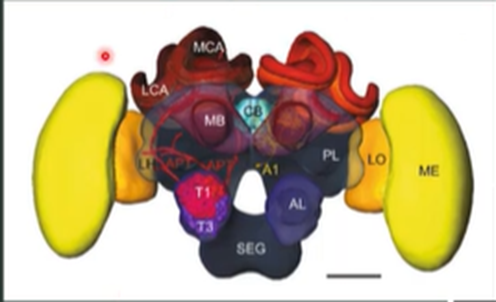
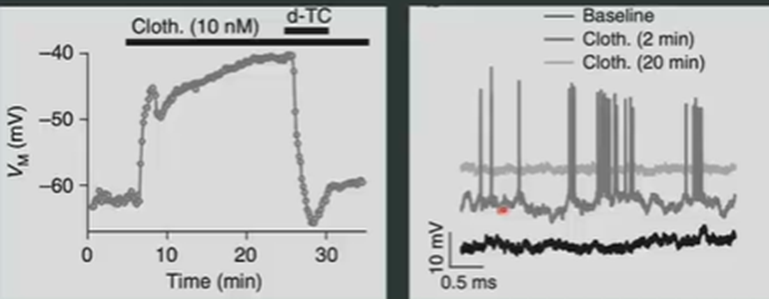
Coumpahos (an organophosphate that inhibits AchE) shows a similar response but causes slower depolarisation initially. The action potentials then cease due to voltage gated Ca2+ and calcium activate dpotassium current in kenyon cells
Suggest theres mechanisms in place to prevent cell death
However, both of these drugs also have effects of redicung the cells responsiveness to their natural agonists
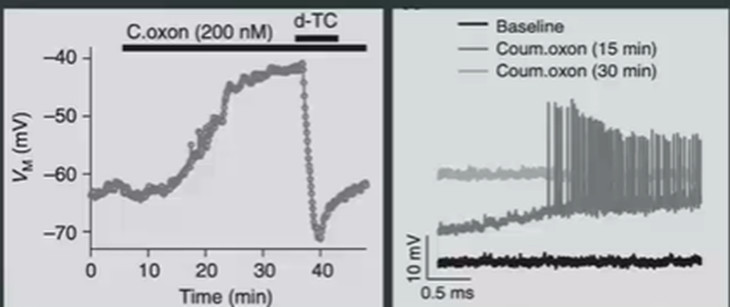
impact in immune function
Clothianodin weakens honeybees' immune functions
The innate immune system tries to encapsulate a foreign body so can illicit immune response by inserting a nylon rod into the insect body and measuring the effect in response to drugs
Clothianodin decreases the insect's immune response (dose dependent effect)
Deformed wing virus (caused by parasites) is more prevalent in insects exposed to clothianodin
Bees actually prefer diets containing neonictanoid insecticides
response to food sources
Honeybees gilius (taste structures) sensilla respond strongly to sucrose and to nicotine. Don’t respond more strongly when sucrose and nicotine present
Suggests that they cant taste the drugs
What is it that gives them this preference for this?
Likely that theres pharmacological action on nicotinic ACh receptors in the brain
Caffeine does however have a bitter taste and can be tasted by bees and is produced naturally by some plants as a deterrent
as we increase caffeine concentration we increase the bees memory and ability to learn
Caffeine increases Kenyon cell responsiveness to Ach
This is because adenosine receptors are much more responsive to Ach when caffeine is also present —> more active cells allows them to form this association
Could be that the insecticides are drugging the bees to come back to them
